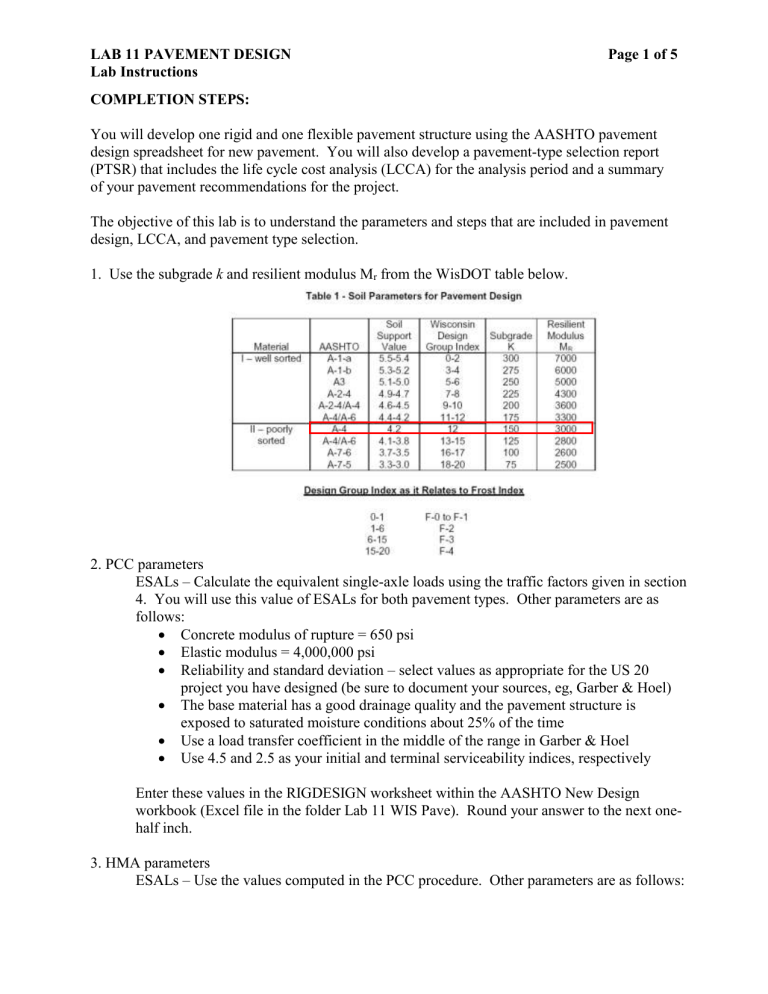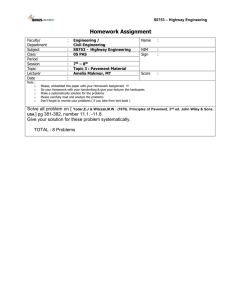
LAB 11 PAVEMENT DESIGN Lab Instructions Page 1 of 5 COMPLETION STEPS: You will develop one rigid and one flexible pavement structure using the AASHTO pavement design spreadsheet for new pavement. You will also develop a pavement-type selection report (PTSR) that includes the life cycle cost analysis (LCCA) for the analysis period and a summary of your pavement recommendations for the project. The objective of this lab is to understand the parameters and steps that are included in pavement design, LCCA, and pavement type selection. 1. Use the subgrade k and resilient modulus Mr from the WisDOT table below. 2. PCC parameters ESALs – Calculate the equivalent single-axle loads using the traffic factors given in section 4. You will use this value of ESALs for both pavement types. Other parameters are as follows: Concrete modulus of rupture = 650 psi Elastic modulus = 4,000,000 psi Reliability and standard deviation – select values as appropriate for the US 20 project you have designed (be sure to document your sources, eg, Garber & Hoel) The base material has a good drainage quality and the pavement structure is exposed to saturated moisture conditions about 25% of the time Use a load transfer coefficient in the middle of the range in Garber & Hoel Use 4.5 and 2.5 as your initial and terminal serviceability indices, respectively Enter these values in the RIGDESIGN worksheet within the AASHTO New Design workbook (Excel file in the folder Lab 11 WIS Pave). Round your answer to the next onehalf inch. 3. HMA parameters ESALs – Use the values computed in the PCC procedure. Other parameters are as follows: LAB 11 PAVEMENT DESIGN Lab Instructions Page 2 of 5 Sub-base CBR = 30 Base CBR = 80 Determine the appropriate values of the layer coefficients and elastic moduli from Figures 20.15, 20.16, and 20.17 in the text. Subgrade resilient modulus of 3,000 Reliability, standard deviation, and initial and terminal serviceability indices as determined in the PCC portion Enter the required values into the worksheet FLEXDESIGN within the workbook AASHTO New Design (Excel file). Go to the FlexLayered worksheet and follow the procedure on the sheet, making sure you start with the Inputs Box below the table. Iterate the process until you have a sufficient design. As discussed in the lecture, the pavement thickness is relatively insensitive to changes in ADT. You will demonstrate this by adjusting the ESAL values. First increase the total ESAL’s by 10% and rerun the model. Now decrease the total to 10% less than your original value. 4. Traffic Parameters a. Construction Year – 2007 b. Construction Year ADT – 7,400 c. Design Year – 2037 d. Growth rate of 1% e. Truck Classification 1%: 2D 2%: 3SU 4%: 2S-1, 2S-2 9%: 3S-2 1%: DBL BTM 5. Layer Thickness Design HMA a. Surface Type – as appropriate from types listed below for your traffic b. Shoulder Material – granular c. Base – Crushed Aggregate Base Course (CABC) with a CBR of 80 d. Sub-base – CABC with a CBR of 30 6. Life Cycle Cost Analysis a. Project Type - Rural b. Project Length – 17 miles LAB 11 PAVEMENT DESIGN Lab Instructions Page 3 of 5 c. Number of AC Alternatives – 1 d. Number of PCC Alternatives – 1 7. Bid Item Costs a. Asphalt Binder, PG 58-28 - $267.61/MG b. HMA Base Course, 1,000,000 ESAL, 19 mm mix - $54.18/MG c. HMA Intermediate Course, 3,000,000 ESAL - $37.47/MG d. HMA Surface Course, 3,000,000 ESAL, Fricl-3 - $37.07/MG e. HMA Surface Course, 10,000,000 ESAL, Fricl-3 - $44.57/MG f. Concrete Pavement, 200 mm - $32.12/SM g. Concrete Pavement, 230 mm - $30.27/SM h. Concrete Pavement, 250 mm - $30.31/SM i. Concrete Pavement, 260 mm - $28.68/SM j. Concrete Pavement, 275 mm - $27.44/SM k. Concrete Pavement, 300 mm - $53.23/SM l. Crushed Aggregate Base Course - $8.60/MG m. Granular Shoulder - $16.13/MG n. Salvaged Asphaltic Pavement, Milling - $16/MG o. Patches, Full-Depth Repair - $106.87/SM p. Pavement Ties - $10/EA q. Dowel Bars - $10/EA r. Sawing Existing Pavement - $4/M s. Sawing Concrete Pavement, Full Depth - $7/M t. Pavement Milling and Stockpiling - $4.00/SM u. Longitudinal Joint Repair - $12.07/M v. Crack and Joint Cleaning and Sealing (HMA) - $1,401.56/KM w. Crack and Joint Cleaning and Sealing (PCC) - $2,720.78/KM x. Transverse Joint Repair - $2.72/M 8. HMA Alternate Description a. Shoulders – granular b. Rural Alternate Cross Section (note that these values are for ½ of the roadway) Roadway Width – 12 meters Structure Width – 7.2 meters Left Shoulder Width – 1.8 meters Left Lane Width – 3.6 meters Right Lane Width – 3.6 meters Right Shoulder Width – 3.0 meters 9. PCC Alternate Description (note that these values are for ½ of the roadway) a. Shoulders – granular b. Base – 150 mm of CABC c. Rural Alternate Cross Section Roadway Width – 12 meters Structure Width – 7.8 meters Left Shoulder Width – 1.8 meters LAB 11 PAVEMENT DESIGN Lab Instructions Page 4 of 5 Left Lane Width – 3.6 meters Right Lane Width – 4.2 meters Right Shoulder Width – 2.4 meters 10. HMA Alternate Quantities and Costs Do the quantities and costs seem reasonable? How do the results of the two methods compare? 11. PCC Alternate Quantities and Costs Do the quantities and costs seem reasonable? 12. HMA Alternate Maintenance and Rehabilitation a. AC Maintenance should be done at years 7, 14, 21, and 26. b. HMA Overlay should be done at year 18. Overlay Thickness – 100 mm Tack Coat Layer – 1 0.113 liter/SM (112 gm/SM) tack coat coverage c. Mill and HMA Overlay should be done at year 30. Overlay Limits – Roadway and Shoulders Milling Limits – Roadway Milling Depth – 75 mm Overlay Depth – 125 mm Asphalt Mix – as appropriate for your design traffic 13. PCC Alternate Maintenance and Rehabilitation a. PCC Maintenance should be done at years 10, 15, and 30 Joint maintenance – assume transverse joint spacing at 6 meters b. PCC Rehabilitation should be done at year 25. Overlay Limits – Roadway and Shoulders Patches – assume 2% of your pavement area Overlay Thickness – 100 mm Asphalt Mix – select as appropriate for your design traffic Tack Coat Layer – 1 0.113 liter/SM (112 gm/SM) tack coat coverage 14. LCCA Results Which alternate has the lower first cost? Assuming the true interest rate is 4% per year, how much extra does the annual maintenance for the lower-cost alternate have to cost to make the two alternates equal in LCC over the 30-year life of the project? LAB 11 PAVEMENT DESIGN Lab Instructions Page 5 of 5 GRADING CONSIDERATIONS: Prepare a summary memorandum that describes the pavement design process, the pavement structure alternatives and your recommendation for the pavement structure. Print out the Excel results and reference them in the summary memorandum. This memorandum should be at least 1 page in length and no more than 3 pages (not including any attachments). As always, include a proper cover sheet. 30% – Summary of Pavement Design Process: List each value you determined from a table or figure and document the table or figure used. 20% – Summary of Pavement Structure Alternatives: List and compare the alternatives you calculated by the two methods. Discuss the sensitivity (% change in pavement thickness for 10% changes in ESAL’s) of the design to minor changes in traffic. Include your comparison of life-cycle costs. 30% – Recommendations: Make and support your recommendation for the type and design values (thickness of each layer, etc.) Discuss your rationale for making the recommendation. BE SURE TO ANSWER THE QUESTIONS LISTED ABOVE! 20 % – Presentation, neatness, grammar, and showing ALL of your calculations



